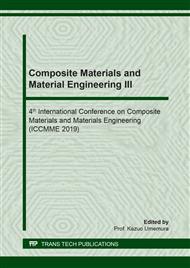p.345
p.351
p.357
p.365
p.371
p.377
p.385
p.391
p.397
Pre-Crack Behaviours of Cement Paste Containing Bacillus pseudofirmus ATCC 700159
Abstract:
The compressive strength of cement paste specimens containing Bacillus pseudofirmus ATCC 700159 was investigated in order to study the self-healing ability in cement specimens. A partial replacement of bacteria suspension by 10%, 20%, 30% and 40% by weight was mixed into the cement paste before casting. At age 28 days of curing in lime water, cement paste specimens were pre-cracked by 40% of maximum compressive strength in order to make the crack allowing moisture and air to pass through. After that, these specimens were left curing in the air until 60 days prior to the compressive test. Results showed that the specimens containing bacteria had a potential to form a new compound which was created by bacteria. XRD and FTIR analysis proved that bacteria could produce carbonate ion and therefore, combined with calcium ion in cement paste becoming calcium carbonate compound. This leads to the increase in compressive strength of pre-cracked specimens where the one with 40% bacteria giving satisfactory results of self-healing cement.
Info:
Periodical:
Pages:
371-376
Citation:
Online since:
May 2019
Keywords:
Price:
Сopyright:
© 2019 Trans Tech Publications Ltd. All Rights Reserved
Share:
Citation:


